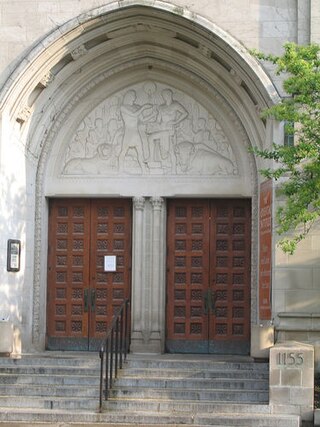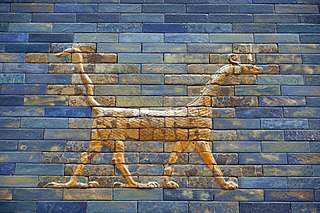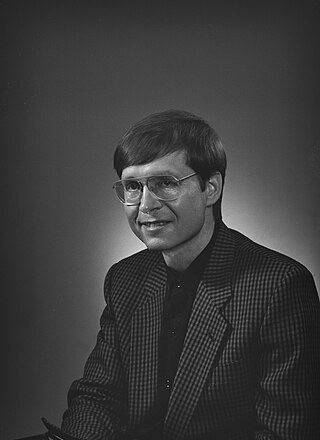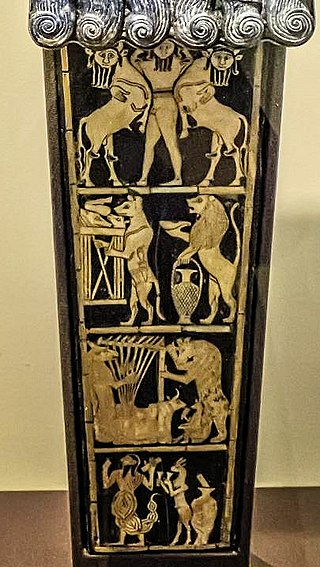Related Research Articles

Akkadian is an extinct East Semitic language that was spoken in ancient Mesopotamia from the third millennium BC until its gradual replacement in common use by Old Aramaic among Assyrians and Babylonians from the 8th century BC.
Rabshakeh is a title meaning "chief of the princes/cup-bearers" in the Semitic Akkadian and Aramaic languages. The title was given to the chief cup-bearer or the vizier of the Akkadian, Assyrian and Babylonian royal courts in ancient Mesopotamia, and revived by the Assyrians as a military rank during World War I.

Nippur was an ancient Sumerian city. It was the special seat of the worship of the Sumerian god Enlil, the "Lord Wind", ruler of the cosmos, subject to An alone. Nippur was located in modern Nuffar 5 miles north of modern Afak, Al-Qādisiyyah Governorate, Iraq. It is roughly 200 kilometers south of modern Baghdad and about 96.56 km southeast of the ancient city of Babylon. Occupation at the site extended back to the Ubaid period, the Uruk period, and the Jemdet Nasr period. The origin of the ancient name is unknown but different proposals have been made.

The Institute for the Study of Ancient Cultures, West Asia & North Africa, established in 1919, is the University of Chicago's interdisciplinary research center for ancient Near Eastern studies and archaeology museum. It was founded for the university by Egyptology and ancient history professor James Henry Breasted with funds donated by John D. Rockefeller Jr. It conducts research on ancient civilizations throughout the Near East, including at its facility, Chicago House, in Luxor, Egypt. The institute also publicly exhibits an extensive collection of artifacts related to ancient civilizations and archaeological discoveries at its on-campus building in Hyde Park, Chicago. According to anthropologist William Parkinson of the Field Museum, the ISAC's highly focused "near Eastern, or southwest Asian and Egyptian" collection is one of the finest in the world.

Lama, Lamma, or Lamassu is an Assyrian protective deity.

Assyriology, also known as Cuneiform studies or Ancient Near East studies, is the archaeological, anthropological, historical, and linguistic study of the cultures that used cuneiform writing. The field covers Pre Dynastic Mesopotamia, Sumer, the early Sumero-Akkadian city-states, the Akkadian Empire, Ebla, the Akkadian and Imperial Aramaic speaking states of Assyria, Babylonia and the Sealand Dynasty, the migrant foreign dynasties of southern Mesopotamia, including the Gutians, Amorites, Kassites, Arameans, Suteans and Chaldeans. Assyriology can be included to cover Neolithic pre-Dynastic cultures dating to as far back as 8000 BC, to the Islamic Conquest of the 7th century AD, so the topic is significantly wider than that implied by the root "Assyria".

The mušḫuššu or mushkhushshu is a creature from ancient Mesopotamian mythology. A mythological hybrid, it is a scaly animal with hind legs resembling the talons of an eagle, lion-like forelimbs, a long neck and tail, two horns on its head, a snake-like tongue, and a crest. The mušḫuššu most famously appears on the Ishtar Gate of the city of Babylon, dating to the sixth century BCE.

Mummu is a Mesopotamian deity. His name is an Akkadian loanword from Sumerian "umun", which translates as "main body, bulk, life-giving force" and "knowledge", as the active part, in contrary to the more lethargic primordial forces of Tiamat and Apsû.

Zincirli Höyük is an archaeological site located in the Anti-Taurus Mountains of modern Turkey's Gaziantep Province. During its time under the control of the Neo-Assyrian Empire it was called, by them, Sam'al. It was founded at least as far back as the Early Bronze Age and thrived between 3000 and 2000 BC, and on the highest part of the upper mound was found a walled citadel of the Middle Bronze Age. New excavations revealed a monumental complex in the Middle Bronze Age II, and another structure that was destroyed in the mid to late 17th century BC, maybe by Hititte king Hattusili I. This event was recently radiocarbon-dated to sometime between 1632 and 1610 BC, during the late Middle Bronze Age II. The site was thought to have been abandoned during the Hittite and Mitanni periods, but excavations in 2021 season showed evidence of occupation during the Late Bronze Age in Hittite times. It flourished again in the Iron Age, initially under Luwian-speaking Neo-Hittites, and by 920 B.C. had become a kingdom. In the 9th and 8th century BC it came under control of the Neo-Assyrian Empire and by the 7th century BC had become a directly ruled Assyrian province.

Argishti I, was the sixth known king of Urartu, reigning from 786 BC to 764 BC. He founded the citadel of Erebuni in 782 BC, which is the present capital of Armenia, Yerevan. Alternate transliterations of the name include Argishtis, Argisti, Argišti, and Argishtish. Although the name is usually rendered as Argišti, some scholars argue that Argisti is the most likely pronunciation. This is due to the belief that the Urartians used the cuneiform symbol š to voice an s-sound, as opposed to representing the digraph sh.

Simo Kaarlo Antero Parpola is a Finnish Assyriologist specializing in the Neo-Assyrian Empire and Professor emeritus of Assyriology at the University of Helsinki.

Tell Fekheriye is an ancient site in the Khabur river basin in al-Hasakah Governorate of northern Syria. It is securely identified as the site of Sikkan, attested since c. 2000 BC. While under an Assyrian governor c. 1000 BC it was called Sikani. Sikkan was part of the Syro-Hittite state of Bit Bahiani in the early 1st millennium BC. In the area, several mounds, called tells, can be found in close proximity: Tell Fekheriye, Ras al-Ayn, and 2.5 kilometers east of Tell Halaf, site of the Aramean and Neo-Assyrian city of Guzana. During the excavation, the Tell Fekheriye bilingual inscription was discovered at the site, which provides the source of information about Hadad-yith'i.

Scorpion-men (Akkadian: 𒄈𒋰𒇽𒍇𒇻, romanized: girtablullû feature in several Akkadian language myths from ancient Mesopotamia, including the epic Enûma Elish and the Standard Babylonian version of the Epic of Gilgamesh.
Adolf Leo Oppenheim was an American assyriologist. He was editor-in-charge of the Chicago Assyrian Dictionary of the Oriental Institute from 1955 to 1974 and John A. Wilson Professor of Oriental Studies at the University of Chicago.
Khirbet Kerak or Beth Yerah is a tell located on the southern shore of the Sea of Galilee in modern-day Israel. The tell spans an area of over 50 acres—one of the largest in the Levant—and contains remains dating from the Early Bronze Age and from the Persian period through to the Early Islamic period.

Erica Reiner was an American Assyriologist and author. From 1974, she was editor of the Chicago Assyrian Dictionary, which was published in 21 volumes over 55 years, being completed in 2011 after her death. Reiner was associated with the Oriental Institute at the University of Chicago. Her work concentrated on developing the Chicago Assyrian Dictionary, the basic reference work for understanding the Akkadian language, the predominant language of Mesopotamia from 2400 BC to 100 AD.
Harry Angier Hoffner, Jr. was an American professor of Hittitology.
The Chicago Hittite Dictionary (CHD) is a project at the University of Chicago Oriental Institute to create a comprehensive dictionary of the Hittite language. The project was founded by Hans Gustav Güterbock and Harry Hoffner in 1975 and funded by the National Endowment for the Humanities. It is currently co-edited by Theo van den Hout and Petra Goedegebuure. Hoffner originally hoped that the project could be completed by 2000, though as of 2005 it was expected to last until 2045. It is one of several dictionary projects at the institute, including the Chicago Assyrian Dictionary and the Chicago Demotic Dictionary.

Šērūʾa-ēṭirat, called Saritrah in later Aramaic texts), was an ancient Assyrian princess of the Sargonid dynasty, the eldest daughter of Esarhaddon and the older sister of his son and successor Ashurbanipal. She is the only one of Esarhaddon's daughters to be known by name and inscriptions listing the royal children suggest that she outranked several of her brothers, such as her younger brother Aššur-mukin-paleʾa, but ranked below the crown princes Ashurbanipal and Shamash-shum-ukin. Her importance could be explained by her possibly being the oldest of all Esarhaddon's children.
Puzrish-Dagan is an important archaeological site in Al-Qādisiyyah Governorate (Iraq). It is best-known for the thousands of clay tablets that are known to have come from the site through looting during the early twentieth century.
References
- ↑ Saxon, Wolfgang (2006-01-22). "Erica Reiner Is Dead at 81; Renowned Assyrian Scholar". The New York Times. Retrieved 2009-02-20.
- 1 2 Wilford, John Noble (2011-06-07). "After 90 Years, a Dictionary of an Ancient World". The New York Times. Retrieved 2011-06-07.
- ↑ Browne, Malcolm W. (1989-07-04). "Scholars Scaling an Unclimbed Peak: Aramaic". The New York Times. Retrieved 2009-02-20.
